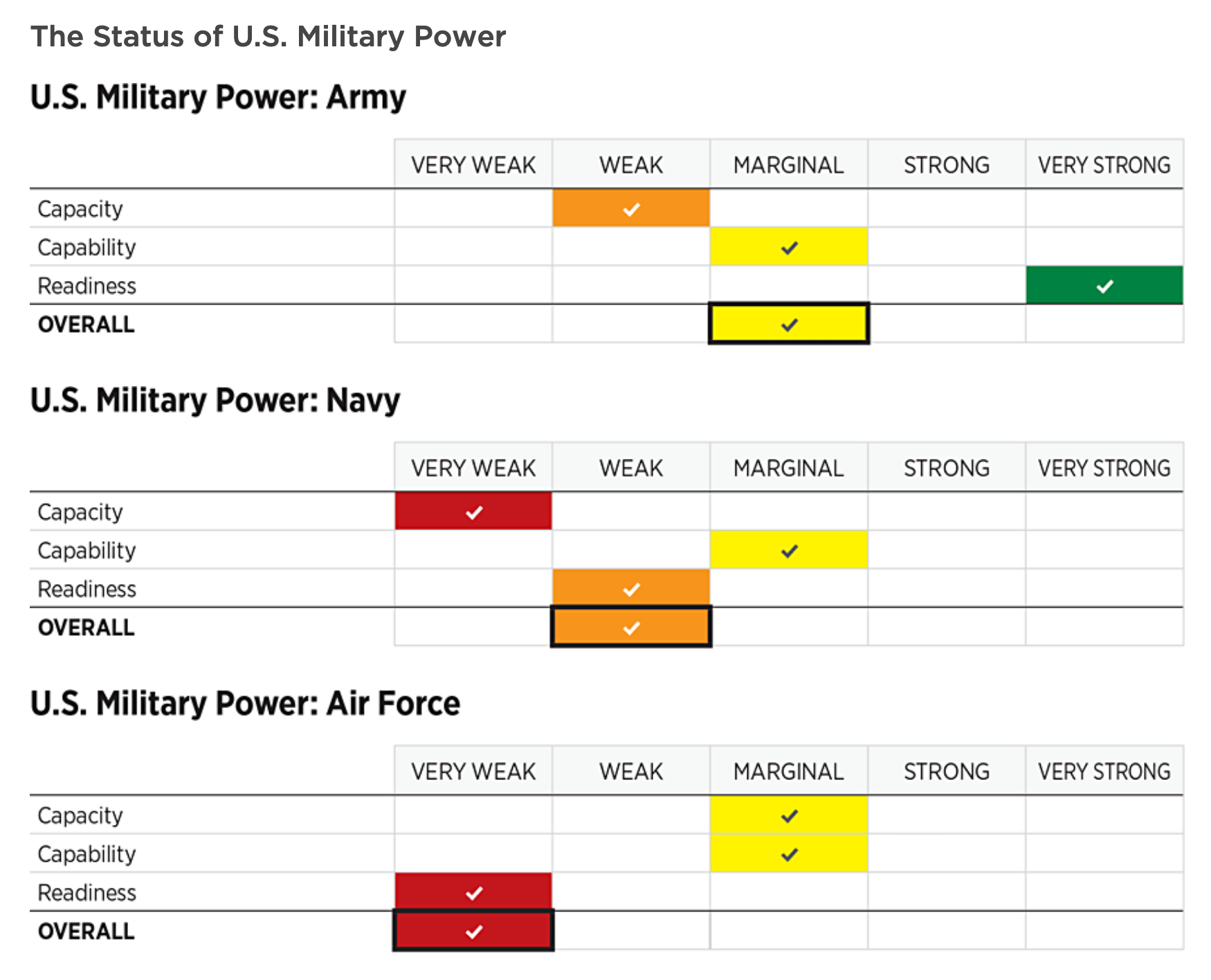U.S. Military at Significant Risk: Heritage Foundation's 2024 Index of Military Strength Reports
This post was originally published on
The Heritage Foundation has released its 2024 Index of U.S. Military Strength, a comprehensive annual assessment that offers a detailed analysis of the United States military's ability to protect national interests. This report, released on January 24, 2024, evaluates the military’s current posture and its capacity to execute missions in today's global security environment.
[
Executive Summary of the 2024 Index of U.S. Military Strength
Executive Summary As currently postured, the U.S. military is at significant risk of not being able to defend America’s vital national interests. This is the inevitable result of years of prolonged deployments, underfunding, poorly defined priorities, wildly shifting security policies, exceedingly poor discipline in program execution, and a profound lack of seriousness across the national security establishment even as threats to U.S. interests have surged. In 2023, this has been compounded by the cost of U.S.
The Heritage Foundation

](
The sobering conclusion drawn from the report is that the U.S. military is at significant risk of not being able to defend America’s vital national interests, an outcome attributed to a confluence of factors including prolonged deployments, underfunding, poorly defined priorities, shifting security policies, and a lack of discipline in program execution.
[
Fiat Wars | Scott Horton
In this episode of The Bitcoin Standard podcast Saifedean Ammous sits down with Scott Horton to discuss the wars of the 21st century that the US has engaged in, how they negatively affect US citizens, and how fiat money fuels them.
 TFTC – Truth for the CommonerStaff
TFTC – Truth for the CommonerStaff

](
Key Findings from the 2024 Index
The Index examines the ease of operating in key regions, the threats to U.S. vital interests, and the condition of the U.S. military’s power, using a framework that judges capability, capacity, and readiness for operations.
Three vital interests are consistently highlighted:
- Defense of the homeland.
- Successful conclusion of a major war with the potential to destabilize a region of critical interest.
- Preservation of freedom of movement within global commons.
The report suggests that to defend these interests effectively, the U.S. requires a military force capable of engaging in two major conflicts simultaneously, echoing the need for a "two-war" capacity.
Global Operating Environment and Threat Assessment
The Index assesses the global operating environment as "favorable" but highlights the complexities and challenges in Europe, the Middle East, and Asia. It specifically notes the strain on European allies due to Russia's war in Ukraine, the destabilizing effects of Iran’s actions in the Middle East, and the tensions in Asia due to China's assertiveness and North Korea's continued provocation.
The threat environment is assessed as "aggressive" for threat actor behavior and "formidable" for the ability to harm U.S. interests, with particular concern over China's military expansion and Russia's aggression in Ukraine.
U.S. Military Power: Service by Service
The Index offers a service-by-service assessment:
- The Army is rated as "Marginal" due to its aging equipment and a size that falls short of what would be needed for two major conflicts.
- The Navy receives a "Weak" score, as its fleet size is too small for its current tasks and technological edges are narrowing.
- The Air Force is characterized as "Very Weak," hindered by an insufficient number of modernized aircraft and a shortage of pilots and flying hours.
- The Marine Corps stands out with a "Strong" rating due to its modernization efforts and readiness, but it is cautioned that the Corps is too small and could face limitations without growth.
- The Space Force is marked as "Marginal," with concerns about its ability to support operational and tactical warfighter requirements.
- Nuclear Capabilities are also rated as "Marginal," reflecting the increased risk in a more dangerous threat environment and the need for rapid adaptation to these developments.



Conclusion and Implications
The cumulative rating for the U.S. military is "Weak," underlining that the current forces might struggle with a single major regional conflict and are ill-equipped for two. The report warns that the military services continue to face challenges in modernization, recruitment, and readiness.
In conclusion, the 2024 Index stresses the urgency for consistent investment in rebuilding the U.S. military to ensure that it is properly sized, equipped, trained, and ready to fulfill national defense missions. As threats continue to emerge with regularity and complexity, the report underscores the importance of serious and consistent investment in the nation’s security by national leaders and the American public.




